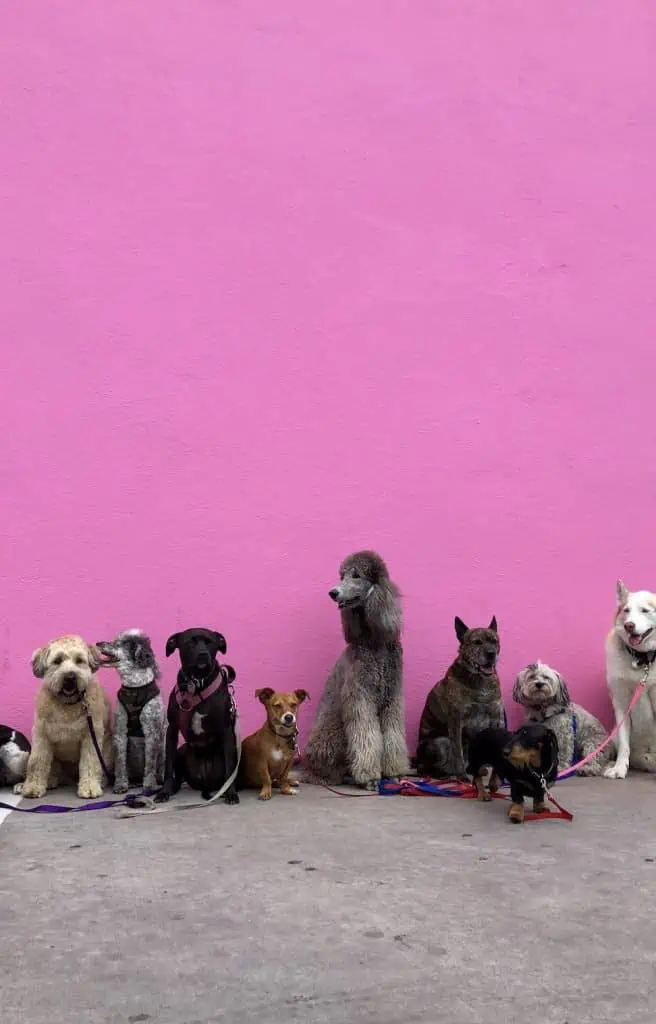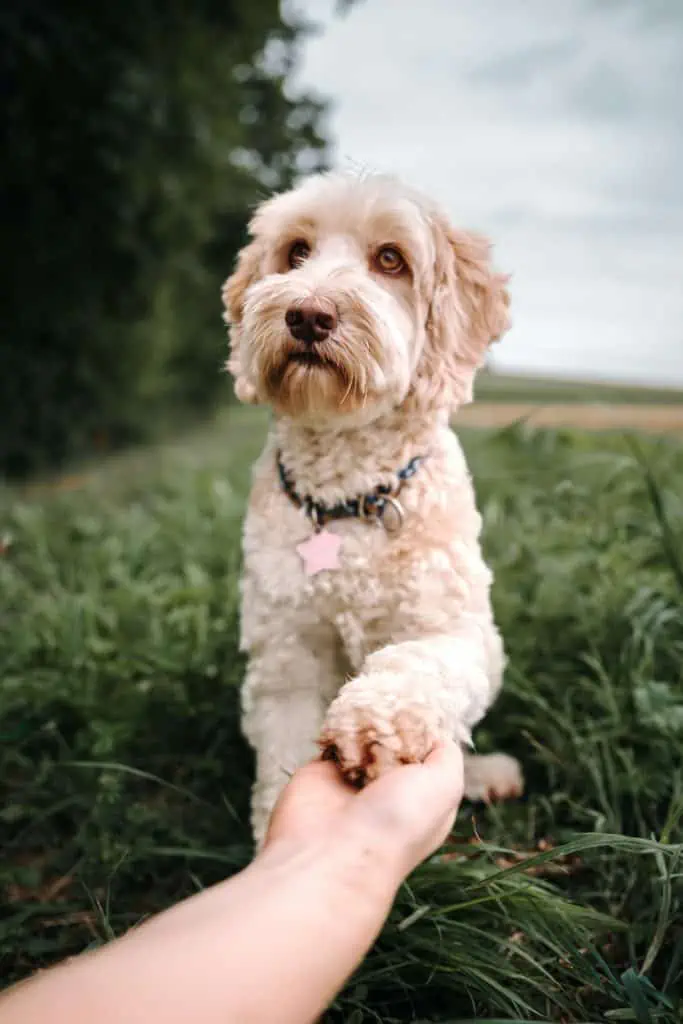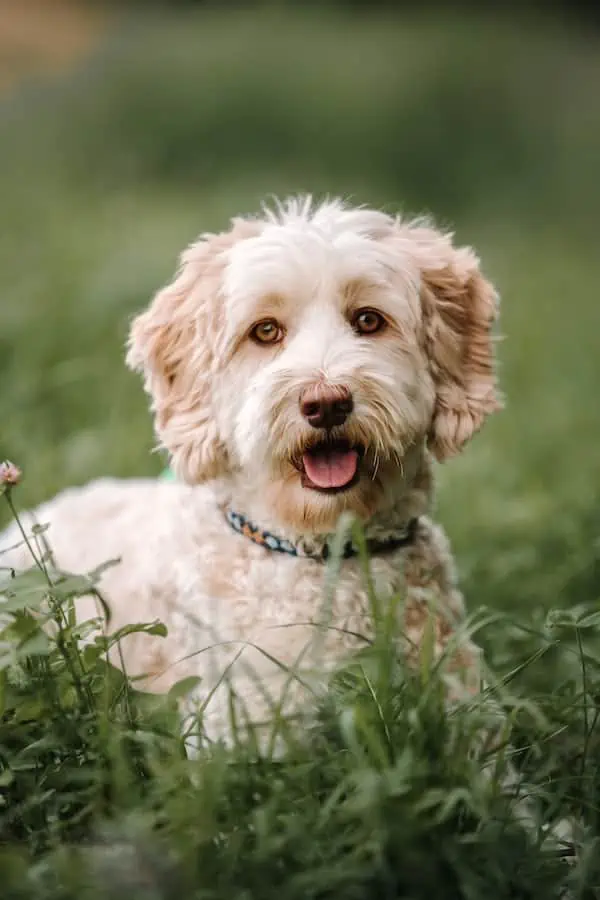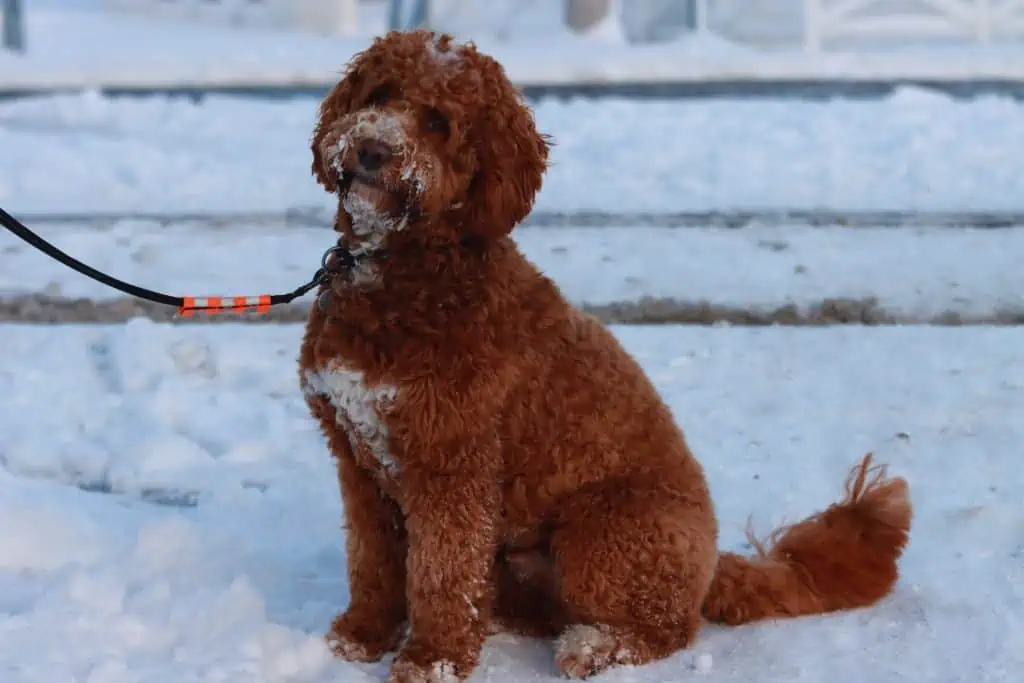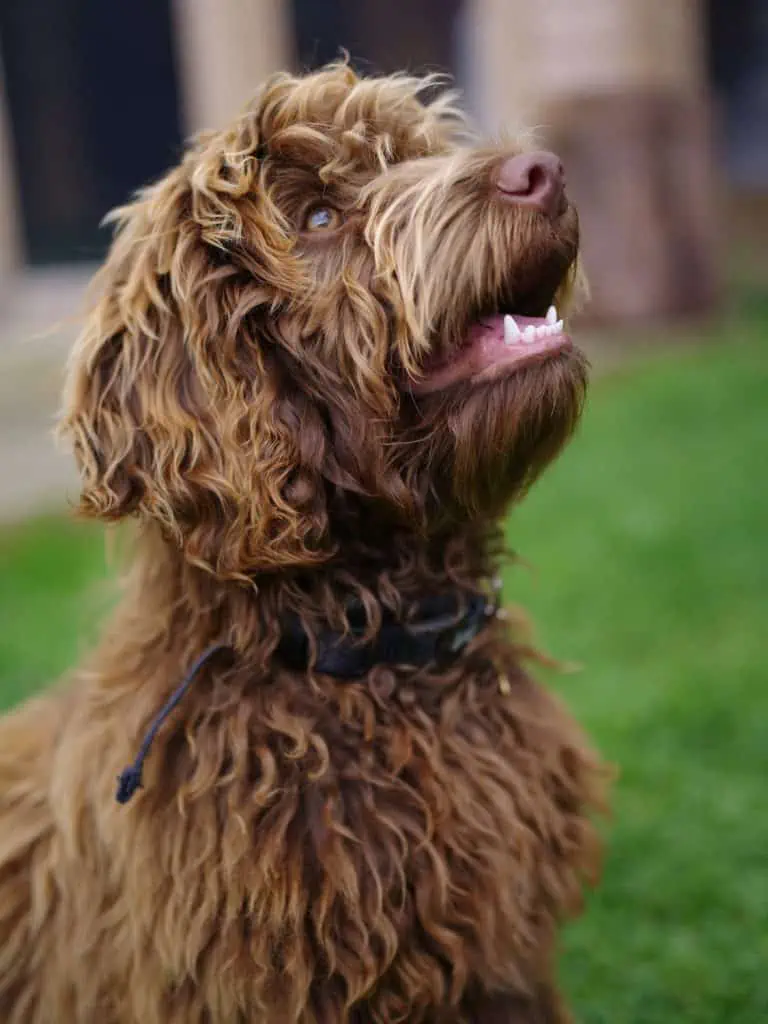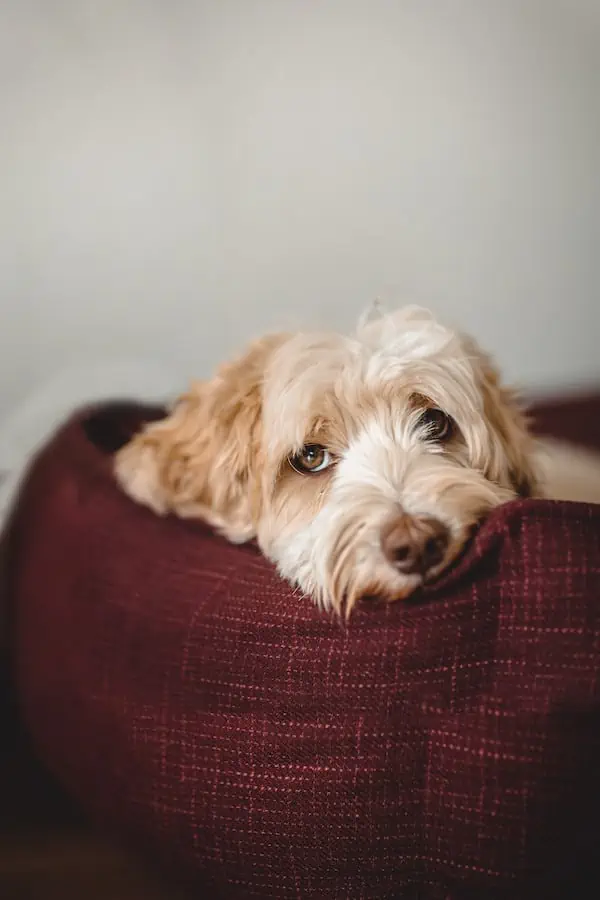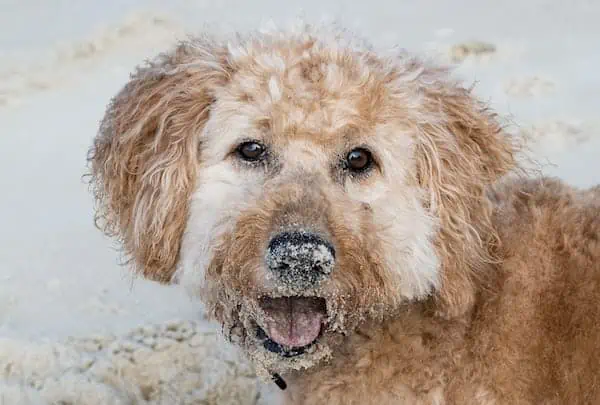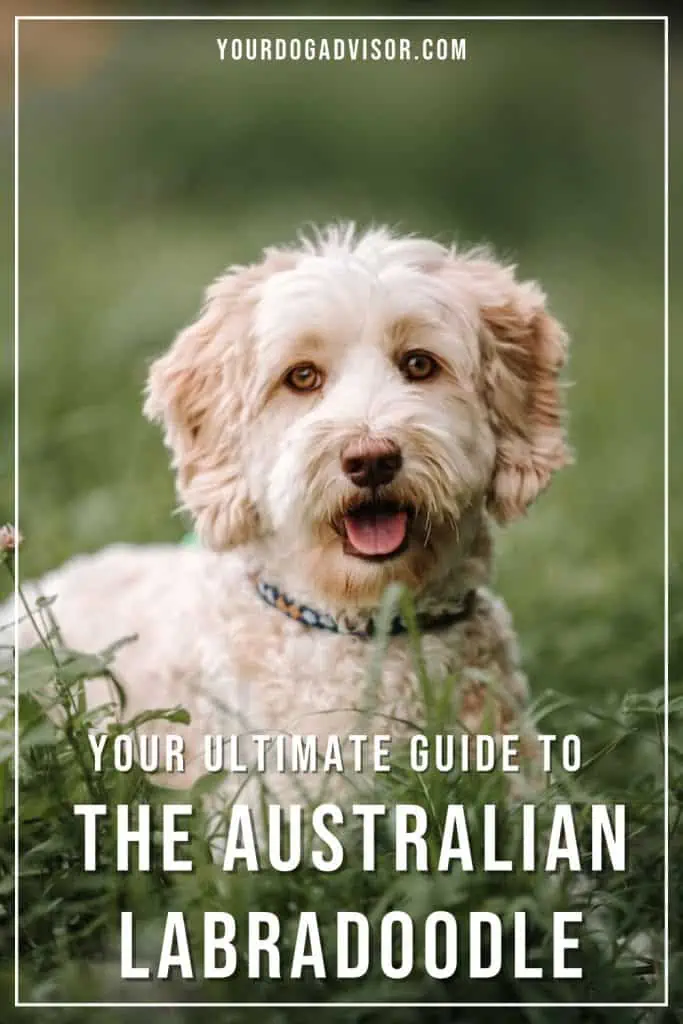Crossbreed dogs, and especially crossbreed doodle dogs, have become increasingly popular over the years.
People love these hybrids for their curly, potentially hypoallergenic coats, their adoring temperaments, and their unique appearance. But while most of us have heard about the Labradoodle, most of us are still learning about his close cousin, the Australian Labradoodle.
So, what is this canine cutie and how can you get your hands on one? That’s what we’re here to find out!
Contents
Designer Dogs, Hybrids, and Crossbreeds – Oh My!
Crossbreed dogs are nothing new. In fact, they are growing more and more in popularity.
There are so many terms for crossbreed dogs that it can make your head spin. Crossbreed dogs, hybrids, designer dogs, and mixed breed dogs are all terms to describe the same type of dog – a dog that has different purebred parents.
Most of the time crossbreed dogs come from two specific purebred parents. Take the Labradoodle, for example. This dog comes from the purebred Labrador Retriever and the purebred Poodle.
Crossbreed dogs are considered different from mutts because they are essentially “designed” to have specific canine lineage in their DNA. For most crossbreed dogs, this includes parent breeds that were chosen in the hopes of creating an offspring that has the best qualities of both.
Unfortunately, there are pros and cons to crossbreeding dogs, especially newer-generation crossbreeds.
For example, crossbreed dogs are considered less predictable than purebred dogs when it comes to their health, temperament, and even appearance. This is because genetics can be so difficult to predict, and you may not always know if your designer dog is going to be more like one parent breed over the other.
It’s also important to note that, while you may pay a premium price for your crossbreed dog, you’re not going to get a dog that is eligible for show because these mixed breeds are not yet recognized as their own breeds by most major breed clubs.
And while most purebred dogs we are familiar with today are the result of crossbreeding, it takes generations for these dogs to be bred and perfected to the point where we can predict aspects of health, temperament, appearance, and coat type.
Still, none of this has hindered the crossbreed craze, and people are lining up in droves to get themselves the next doodle dog on the list!
And what is that latest poodle hybrid? Enter the adorable Australian Labradoodle!
Say Hello To The Australian Labradoodle
The Australian Labradoodle is a mix between the Cocker Spaniel, the Poodle, and the Labrador.
The Australian Labradoodle is a unique type of crossbreed. Where most crossbreed dogs have two parent breeds, the Australian Labradoodle comes from three different dogs.
That’s right, this is a mix between the Labrador Retriever, the Poodle, and the Cocker Spaniel.
Of course, you can’t breed three dogs, so you’re not likely to have an Australian Labradoodle that is equally one-third of each purebred dog. Instead, the most common mix of this hybrid is a Labradoodle mixed with a Cocker Spaniel.
The result is an adorable dog that is known for his playful personality and high level of intelligence.
Let’s take a look at some basic stats of the Australian Labradoodle:
Height: 21 to 24 Inches
Weight: 15 to 65 pounds
Temperament: Intelligent, Friendly, Sweet Natured, Family-Oriented
Lifespan: 12 to 15 Years
Coat Type: Potentially hypoallergenic though not guaranteed
coat Colors: Chocolate, Caramel, Parti, Red, Cream, Brown, Black, Black and White, Black and Colored
With all of those above stats noted, it can be difficult to predict exactly what the Australian Labradoodle will behave like, and the easiest way to determine what you could wind up with when it comes to this mix is to take a closer look at his parent breeds.
The Labradoodle
Labradoodles are a mix between the family-friendly Labrador Retriever and the intelligent Poodle. This dog is famous for his energetic personality, curly coat, and ability to get along with just about anyone he meets.
These dogs were originally bred as therapy dogs for those who struggled with allergies and couldn’t work with traditional Labrador Retrievers due to their shedding coats.
What resulted was a Labradoodle craze once people recognized how adorable, friendly, and affectionate these dogs could be.
Today, Labradoodle dogs come in different size varieties including miniature and standard, and they make great companions for families and first-time dog owners who are active and enjoy the outdoors.
The Cocker Spaniel
The purebred Cocker Spaniel is beloved for his calm, devoted nature. He has long ears and an endearing face, and he certainly has the disposition to match his looks. This is one Spaniel dog that is known to be nothing short of sweet and gentle with children and other pets and simply happy to be along for any adventure with his human family.
Cocker Spaniels were originally bred to be a hunter’s companion, and they were once used to help locate and expose game for bird hunters.
Today, they are coveted companions for many households across the United States.
And though they are so beloved, Cocker Spaniel dogs do have shedding coats that shed year-round, with most fur shed during the shedding season in spring and fall. This means that the Cocker Spaniel may not be ideal for allergy sufferers, and this can make an Australian Labradoodle an ideal alternative to those who love the Cocker Spaniel’s famously sweet nature.
However, we should note that, as with any crossbreed, the Australian Labradoodle may not always have a hypoallergenic coat. If you’re looking for an Australian labradoodle specifically that is hypoallergenic, it’s best to go through breeders who specialize in this type of dog and who can provide you with third or fourth generations of the mix.
But we will talk more about this further down. For now, let’s talk more about the temperament of these adorable mixed breeds.
The Australian Labradoodle Temperament And Training
These clever dogs have a wonderful temperament, though they could have a high prey drive.
The Labrador Retriever is the United State’s most popular dog, and for good reason. He is cute, family-friendly, and an excellent addition to first-time dog owners. The Poodle is similar, with his natural flair for showmanship and ability to entertain, he makes a fun and often funny companion.
Mix the two of these breeds and you often get the best of both worlds. When you combine the Cocker Spaniel, you’re likely to get a sweet, affectionate, somewhat mild-mannered dog that is both intelligent and playful.
This makes the Australian Labradoodle the ideal family dog for those with children and other dogs in the home, though we should note that the Australian Labradoodle could be prone to having a high prey drive.
This is because all three of this dog’s purebred ancestors were originally bred for hunting purposes, so it’s best to make sure you implement training at an early age to rescue behavioral issues or the chasing of smaller animals like cats, rabbits, or squirrels.
Luckily, training an Australian Labradoodle should be a piece of cake, so long as the right steps are taken.
As with all dogs, the Australian Labradoodle does best when trained using positive reinforcement training techniques. This should include using treats and praise as opposed to scolding and punishment, and aversive training methods could lead to your Australian Labradoodle losing confidence and shutting down.
We also recommend keeping training short, fun, and game-like to help hold your Australian Labradoodle’s attention. The good news is that these dogs are very eager to please and quite intelligent.
When training is done right, they will likely enjoy the sessions and be quick to learn from you. Training your Australian Shepherd should begin early on in puppyhood and continue throughout his lifetime.
Not only will routine training help to keep your Australian Labradoodle happy, healthy, and well-rounded, but it will also help keep him mentally healthy as well. Best of all, proper training can help enhance the bond built between the two of you.
And even though the Australian Labradoodle is generally a happy and social dog, it’s still important to implement early socialization. Socializing your dog means that you should introduce him to as many new experiences, people, animals, and environments as possible early on to help him develop positive associations with these things.
When it comes to socializing your Australian Labradoodle, it’s equally important not to force him into a situation that you can see is stressful or scary for him. Instead, encourage him gently using praise, treats, and patience.
Best Tips For Exercising An Australian Labradoodle
Because these dogs are high-energy, they require routine exercise.
Along with routine training, your Australian Labradoodle should have proper exercise each and every day. While Cocker Spaniels are a bit more laid back than Labradoodles, both of these dogs are still quite energetic and active.
The best exercise for an Australian Labradoodle is going to be a good walk that lasts about 45 minutes to an hour each day. You might also include free playtime in a backyard or at a dog park, where your Australian Labradoodle can run and play with other dogs of his same size and weight.
Proper exercise for an Australian Labradoodle will not only help reduce behavioral issues that could result from boredom or anxiety, but it can also help keep your dog healthy. Exercising your dog every day helps reduce potential bone and joint issues and can prolong issues like arthritis as your dog ages.
And while physical exercise is important for your Australian Labradoodle, we certainly can’t forget about mental stimulation.
As with all intelligent dog breeds, the Australian Labradoodle is going to need plenty of mental stimulation throughout the day to help keep his clever mind busy.
Without proper mental stimulation, the Australian Labradoodle can become bored and this can lead to destructive behaviors like chewing and barking.
To avoid this, consider investing in proper chew toys and puzzle toys that are safe for your dog to play with while you are away. You can also invest in products like snuffle mats, which encourage your dog’s natural instinct to forage and use his sense of smell.
RundA Snuffle Mat For Dogs
No products found.
The RundA Snuffle Mat above is one of our favorite snuffle mats for dogs like the Australian Labradoodle. It not only encourages dogs to use their natural instincts to find treats and goodies in the cloth, but it helps to keep their brain active and even makes them feel as if they are doing a job.
You can use snuffle mats as a form of slow feeding during mealtime, or you can use it as a way to keep your dog busy while you’re working or distracted.
How To Grooming An Australian Labradoodle
Grooming these dogs can take time and commitment, especially if their fur grows out long and becomes matted.
Grooming your Australian Labradoodle is incredibly important, though the exact grooming your unique Australian Labradoodle is going to need could vary depending on the coat type your dog inherits from his parent breeds.
First or second-generation Australian Labradoodles may not always have hypoallergenic coats, and this could mean you need to use different grooming techniques to keep their skin and fur healthy.
However, for the most part, grooming your Australian Labraodoole consists of ensuring he is properly brushed to reduce matting and tangles in his wavy or curly fur. It’s important to invest in quality brushes and combs that are designed for curly fur, and to brush your dog routinely. We also suggest brushing your Australian Labradoodle dog’s teeth daily, especially seeing as dental disease is one of the leading health issues in dogs across the board, regardless of their breed.
Vet’s Best Dog Toothbrush and Toothpaste
No products found.
One of our favorite dog toothbrushes and toothpaste for the Australian Labradoodle dog is the above Vet’s Best toothbrush. We like that it contains an enzymatic gel toothpaste that is canine-friendly and helps to remove plaque while protecting your dog’s teeth from dental decay and buildup that can lead to health issues down the road.
The toothpaste is also flavored, helping dogs to enjoy the process of having their teeth brushed because they like the taste.
Along with routine brushing and dental care, you should also take time to trim your Australian Labradoodle’s nails. This should be done at least once every two to three weeks, depending on how active your dog is.
Bathing is also important, but it should not be overdone as too much bathing can actually strip your dog’s coat of the essential oils it produces that help keep his skin and coat healthy.
When bathing your dog, it’s important to use a high-quality dog shampoo that is safe for your dog’s skin and coat and that promotes the production of the natural oils in his fur.
Last, Australian Labradoodle dogs can be prone to ear infections, so be sure to keep your dog’s ears clean by using a doggy ear cleaner product you trust. If you’re not sure which type of ear cleaner would be best, we suggest speaking with your veterinarian for tips.
And Speaking Of Health, Is The Australian Labradoodle Healthy?
Luckily, Australian Labradoodle dogs are generally healthy overall.
One of the benefits of crossbreed dogs is that they have the potential benefit of hybrid vigor. Hybrid vigor is the idea that crossbreed dogs may be healthier than their purebred counterparts thanks to the fact that they have a widened gene pool and thus may be less likely to inherit certain genetic health issues.
Because the Australian Labradoodle is a mix of three different types of dogs, he may be even healthier than most.
However, it’s also important to understand that you can’t predict genetics, and your Australian Labradoodle may still be prone to any of the same genetic health issues of all three of his purebred ancestors.
When it comes to the Australian Labradoodle, which has a lifespan of between 12 and 15 years, he can be prone to suffering from
- Patellar Luxation
- Hip Dysplasia
- Addison’s Disease
- Progressive Retinal Atrophy
- Ear Infections
- And Elbow Dysplasia
And while the Australian Labradoodle is primarily a healthy dog, it’s still important to take steps to ensure you get him from a reputable breeder or rescue that you trust.
It’s also important to keep your Australian Labradoodle on quality dog food specified for his age, weight, and activity level, and dog food that contains real animal protein, carbs, fatty acids, minerals, vitamins, and other nutrients your dog needs to thrive.
Another way to ensure your dog’s health overall is to make sure you keep up with routine grooming, training, and exercise. Of course, like all dogs, the Australian Labradoodle should also maintain routine veterinarian visits and wellness exams.
How To Find An Australian Labradoodle Puppy Or Rescue
These dogs are highly sought after, so they could cost you a pretty penny.
Do you think the Australian Labradoodle is right for you? You’re not alone! In fact, this hybrid dog is quickly becoming one of the most popular crossbreeds in the United States, catching up to his Labradoodle cousin.
For this reason, Australian Labradoodles can be somewhat costly when going through a reputable breeder, often costing potential owners between $1,500 and $3,000. In fact, the average price of an Australian Labradoodle puppy is around $2,800. Yikes!
But is it worth it? Many owners say it is indeed. These dogs make fabulous companions for families, singles, and active seniors alike. They are highly trainable, social, friendly, and sweet.
Luckily, you do have the option of rescuing an Australian Labradoodle, although finding one of these highly coveted crossbreeds in a shelter could be hit or miss.
Still, it may be worth the wait. Not only will you save money by rescuing an Australian Labradoodle, but you’ll also be opening up space in a shelter and providing a dog in need a loving forever home.
So, are you considering investing in an Australian Labradoodle? Tell us in the comment section below!
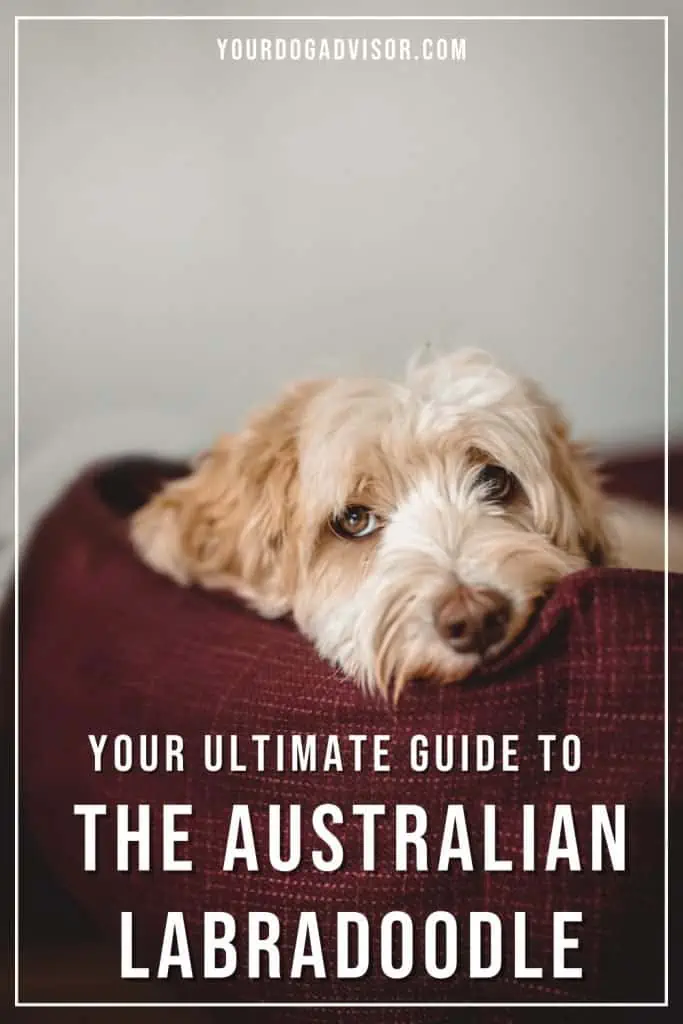

Jen Jones is a professional dog trainer and behavior specialist with more than 25 years of experience. As the founder of ‘Your Dog Advisor’ and the ‘Canine Connection’ rehabilitation center, she applies a holistic, empathetic approach, aiming to address root causes rather than merely treating symptoms.
Well known for her intuitive and compassionate approach, Jen adopts scientifically-proven, reward-based methods, encouraging positive reinforcement over punishment. Jen specializes in obedience training, behavior modification, and puppy socialization. Her innovative methods, particularly in addressing anxiety and aggression issues, have been widely recognized. Jen has worked with many of the world’s leading dog behaviorists and in her free time volunteers with local animal shelters and rescue groups.
